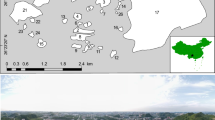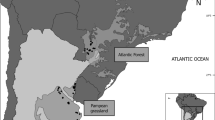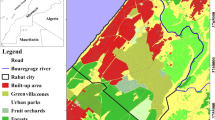Abstract
Quantifying the impacts that invasive alien species (IAS) cause on affected systems is not an easy task. Here, we explore the application of variation partitioning techniques to measure and control for the effects of possible confounding factors when studying the impact that feral pigeons, European starlings, and house sparrows cause on native urban bird communities in Mexico. We argue that these IAS are provoking a severe impact on whole assemblages of native passerines only if (a) their marginal effect is statistically significant, (b) it remains so after partialling out other explanatory variables, and (c) is larger than (or similar to) the conditional effect of these covariates. We censused passerine bird assemblages and measured habitat variables in a number of greenspaces in three replicate study areas. Then, by means of partial redundancy analyses, we decomposed the total variability in bird data as a function of IAS, physical variables and vegetation data. In one of the study areas the marginal effect of IAS on native assemblages was significant, but the conditional effect was not. We conclude that this IAS effect was confounded with other explanatory variables. In the other study areas, no (marginal or partial) significant effect was found. Without invoking interspecific competition, our results support the opportunistic hypothesis, according to which IAS can exploit ecological conditions in modern cities that native species cannot even tolerate. Finally, apart from the Precautionary Principle, we found no scientific justification to control the abundance of the three IAS in our study areas.



Similar content being viewed by others
References
Barney JN, Tekiela DR, Dollete ES, Tomasek BJ (2013) What is the “real” impact of invasive plant species? Front Ecol Environ 11:322–329
Bellard C, Genovesi P, Jeschke JM (2016) Global patterns in threats to vertebrates by biological invasions. Proc R Soc B 283:20152454
Bibby CJ (2004) Bird diversity survey methods. In: Sutherland WJ, Newton I, Green RE (eds) Bird ecology and conservation. A handbook of techniques. Oxford University Press, Oxford, pp 1–16
Blackburn TM, Lockwood JL, Cassey P (2009) Avian invasions. Oxford University Press, Oxford
Borcard D, Legendre P, Drapeau P (1992) Partialling out the spatial component of ecological variation. Ecology 73:1045–1055
Cabe PR (1993) European starling (Sturnus vulgaris). In: Poole A, Gill F (eds) The birds of North America, No. 48. The American Ornithologists’ Union, Philadelphia
Carbó-Ramírez P, Zuria I (2011) The value of small urban green spaces for birds in a Mexican city. Landsc Urban Plan 100:213–222
Chace JF, Walsh JJ (2006) Urban effects on native avifauna: a review. Landsc Urban Plan 74:46–69
Charre GM, Hurtado JAZ, Néve G, Ponce-Mendoza A, Corcuera P (2013) Relationships between habitat traits and bird diversity and composition in selected urban Green áreas of Mexico City. Ornitol Neotrop 24:275–293
Clergeau P, Levesque A, Lorvelec O (2004) The precautionary principle and biological invasion: the case of the house sparrow on the lesser antilles. Int J Pest Manag 50:83–89
Cooper CB, Hochachka WM, Dhondt AA (2007) Contrasting natural experiments confirm competition between house finches and house sparrows. Ecology 88:864–870
Cox GW (2004) Alien species and evolution. The evolutionary ecology of exotic plants, animals, microbes, and interacting native species. Island Press, Washington
Cushman SA, McGarigal K (2002) Hierarchical, multi-scale decomposition of species–environment relationships. Landscape Ecol 17:637–646
Davis MA (2003) Biotic globalization: does competition from introduced species threaten biodiversity? Bioscience 53:481–489
Davis MA (2009) Invasion biology. Oxford University Press, Oxford
Davis MA et al (2011) Don’t judge species on their origins. Nature 474:153–154
De Poorter M (2009) International legal instruments and frameworks for invasive species. In: Clout MN, Williams PA (eds) Invasive species management. A handbook of principles and techniques. Oxford University Press, Oxford, pp 108–125
Dhondt AA (2012) Interspecific competition in birds. Oxford University Press, Oxford
Evans T, Kumschick S, Blackburn TM (2016) Application of the Environmental Impact Classification for Alien Taxa (EICAT) to a global assessment of alien bird impacts. Divers Distrib 22:919–931
Fischer JD, Schneider SC, Ahlers AA, Miller JR (2015) Categorizing wildlife responses to urbanization and conservation implications of terminology. Conserv Biol 29:1246–1248
Fonderflick J (1998) Méthodes d’étude des peuplements d’oiseaux. Centre d’Expérimentation Pédagogique. Florac 23, Florac
Francis CD, Blickley JL (eds) (2012) The influence of anthropogenic noise on birds and bird studies. Ornithological monographs, No. 74. The American Ornithologists’ Union, Texas
Garza G (2002) Evolución de las ciudades mexicanas en el siglo XX. Notas. Rev Inf Anál 19:7–16
Gómez-Aíza L, Zuria I (2012) Registros del estornino pinto (Sturnus vulgaris) en la ciudad de Pachuca, Hidalgo y evidencias de actividad reproductiva. Huitzil 13:146–150
González-Oreja JA (2011) Birds of different biogeographic origins respond in contrasting ways to urbanization. Biol Cons 144:234–242
González-Oreja JA (2017) Relationships of area and noise with the distribution and abundance of songbirds in urban greenspaces. Landsc Urban Plan 158:177–184
González-Oreja JA, Bonache Regidor C, Buzo Franco D, de la Fuente Díaz Ordaz AA, Hernández Santín L (2007) Caracterización ecológica de la avifauna de los parques urbanos de la Ciudad de Puebla (México). Ardeola 54:53–67
González-Oreja JA, De la Fuente-Díaz-Ordaz AA, Hernández-Santín L, Bonache-Regidor C, Buzo-Franco D (2012) Can human disturbance promote nestedness? Songbirds and noise in urban parks as a case study. Landsc Urban Plan 104:9–18
Gregory RD, Gibbons WG, Donald PF (2004) Bird census and survey techniques. In: Sutherland WJ, Newton I, Green RE (eds) Bird ecology and conservation. A handbook of techniques. Oxford University Press, Oxford, pp 17–55
Gurevitch J, Padilla DK (2004) Are invasive species a major cause of extinctions? Trends Ecol Evol 19:470–474
Hutto RL (1985) Seasonal changes in the habitat distribution of transient insectivorous birds in Southeastern Arizona: competition mediated? Auk 102:120–132
INEGI (2017) Instituto Nacional de Estadística y Geografía. http://www.inegi.org.mx/. Last accessed 29 May 2017
Jeschke JM, Bacher S, Blackburn TM, Dick JTA, Essl F, Evans T, Gaertner M, Hulme PE, Kühn I, Mrugała A, Pergl J, Pyšek P, Rabitsch W, Ricciardi A, Richardson DM, Sendek A, Vilà M, Winter M, Kumschick A (2014) Defining the impact of non-native species. Conserv Biol 28:1188–1194
Kath J, Maron M, Dunn PK (2009) Interspecific competition and small bird diversity in an urbanizing landscape. Landsc Urban Plan 92:72–79
Koenig WD (2003) European starlings and their effect on native cavity-nesting birds. Conserv Biol 17:1134–1140
Kumschick S et al (2015) Ecological impacts of alien species: quantification, scope, caveats, and recommendations. Bioscience 65:55–63
Legendre P, Legendre L (2012) Numerical ecology, 3rd edn. Elsevier, Amsterdam
Lepczyk CA, Warren PS (2012) Urban bird ecology and conservation. Studies in Avian biology (no. 45). University of California Press, Berkeley
Luniak M (2004) Synurbization—adaptation of animal wildlife to urban development. In: Shaw WW, Harris LK, Larry V (eds) Proceedings of the 4th international symposium on urban wildlife conservation. School of Natural Resources, College of Agriculture and Life Sciences, University of Arizona, Tucson, Arizona, pp 50–53
MacDougall AS, Turkington R (2005) Are invasive species the drivers or passengers of change in degraded ecosystems? Ecology 86(1):42–55
MacGregor-Fors I, Moráles-Pérez L, Quesada J, Schondube JE (2010) Relationship between the presence of house sparrows (Passer domesticus) and neotropical bird community structure and diversity. Biol Invasions 12:87–96
Marzluff JM, Rodewald AD (2008) Conserving biodiversity in urbanizing areas: nontraditional views from a bird’s perspective. Cities Environ 1:article6, 27 pp
McClure CJW, Estep LK, Hill GE (2011) A multi-scale analysis of competition between the house finch and house sparrow in the southwestern United States. Condor 113:462–468
Moller AP (2009) Successful city dwellers: a comparative study of the ecological characteristics of urban birds in the Western Palearctic. Oecologia 159:849–858
Niemelä J, Kotze J, Yli-Pelkonen V (2009) Comparative urban ecology: challenges and possibilities. In: McDonnell MJ, Hahs AK, Breuste JH (eds) Ecology of cities and towns: a comparative approach. Cambridge University Press, Cambridge, pp 9–24
Ortega-Álvarez R, MacGregor-Fors I (2010) What matters most? Relative effect of urban habitat traits and hazards on urban park birds. Ornitología Neotropical 21:519–533
Ortega-Álvarez R, MacGregor-Fors I (2011) Conociendo al gorrión casero: Variación de la abundancia de Passer domesticus en diferentes tipos de uso de suelo de la ciudad de México. El canto del Centzontle 2:15–28
Parker IM, Simberloff D, Lonsdale WM, Goodell K, Wonham M, Kareiva PM, Williamson MH, Von Holle B, Moyle PB, Byers JE, Goldwasser L (1999) Impact: toward a framework for understanding the ecological effects of invaders. Biol Invasions 1:3–19
Parris KM (2016) Ecology of urban environments. Wiley-Blackwell, Chichester
Pearce F (2015) The new wild. Why invasive species will be nature’s salvation. Beacon Press, Boston
Pennington DN, Blair RB (2012) Using gradient analysis to uncover pattern and process in urban bird communities. In: Lepczyk CA, Warren PS (eds) Urban bird ecology and conservation. Studies in Avian Biology (no. 45). University of California Press, Berkeley, pp 9–32
Peres-Neto PR, Legendre P, Dray S, Borcard D (2006) Variation partitioning of species data matrices: estimation and comparison of fractions. Ecology 97:2614–2625
Perrings C (2011) Invasion economics. In: Simberloff D, Rejmánek M (eds) Encyclopedia of biological invasions. University of California Press, Berkeley, pp 375–378
Pimentel D et al (2002) Economic and environmental threats of alien plants, animal, and microbe invasions. In: Pimentel D (ed) Biological invasions. Economic and environmental costs of alien plant, animal, and microbe species. CRC Press, Boca Raton, pp 307–329
Ralph CJ et al (1996) Manual de métodos de campo para el monitoreo de aves terrestres. General Technical Report PSW-GTR-159. Pacific Southwest Research Station, Forest Service, U.S. Department of Agriculture, Albano, CA
Rebolo Ifran N, Fiorini VD (2010) European starling (Sturnus vulgaris): population density and interactions with native species in Buenos Aires urban parks. Ornitol Neotrop 21:507–518
Ricciardi A (2013) Invasive species. In: Meyers RA (ed) Encyclopedia of sustainability science and technology. Springer, New York, pp 161–178
Richardson DM, Ricciardi A (2013) Misleading criticisms of invasion science: a field guide. Divers Distrib 19:1461–1467
Russel JC, Blackburn TM (2017) The rise of invasive species denialism. Trends Ecol Evol 32:3–6
Rzedowski J (1978) Vegetación de México. Limusa, México
Sarukhán J et al (2009) Capital natural de México. Síntesis: Conocimiento actual, evaluación y perspectivas de sustentabilidad. Comisión Nacional para el Conocimiento y Uso de la Biodiversidad, México
Shochat E, Ovadia O (2011) Invasion, evenness, and species diversity in human-dominated ecosystems. In: Lopez Pujol J (ed) The importance of biological interactions in the study of biodiversity. InTech, London, pp 75–88
Shochat E, Lerman S, Fernández-Juricic E (2010) Birds in urban ecosystems: population dynamics, community structure, biodiversity, and conservation. Aitkenhead-Peterson J, Volder A (eds) Urban ecosystem ecology. Madison, American Society of Agronomy, Crop Science Society of America, Soil Science Society of America, pp 75–86
Simberloff D (2013) Invasive species. What everyone needs to know. Oxford University Press, Oxford
Simberloff D et al (2013) Impacts of biological invasions: what’s what and the way forward. Trends Ecol Evol 28:58–66
Sodhi NS (2011) Birds. In: Simberloff D, Rejmánek M (eds) Encyclopedia of biological invasions. University of California Press, Berkeley, pp 70–74
Sol D, Bartomeus I, Griffin AS (2012) The paradox of invasion in birds: competitive superiority or ecological opportunism? Oecologia 169:553–564
Sol D, Lapiedra O, González-Lagos C (2013) Behavioural adjustments for a life in the city. Anim Behav 85:1101–1112
ter Braak CJF, Smilauer P (2012) Canoco 5.0. Reference manual and user’s guide. Wageningen, Biometris
Weitzel NH (1988) Nest-site competition between the European Starling and native breeding birds in northwestern Nevada. Condor 90:515–517
Wiens JA (1989) The ecology of bird communities. Volume 2, processes and variations. Cambridge University Press, Cambridge
Acknowledgements
We acknowledge the many intelligent comments and suggestions by two anonymous reviewers to previous versions of this paper. JA thanks all the students that helped him with field work in SA2: A.L. Barillas Gómez, C. Bonache Regidor, D. Buzo Franco, A.A. De la FuenteDíaz Ordaz, J. García Guzmán and L. Hernández Santín. JA and IZ thank REFAMA, Red Temática CONACYT 251272 Biología, Manejo y Conservación de la Fauna Nativa en Ambientes Antropizados, for their support. Finally, JA also thanks PRODEP Project BUAP-PTC-522, and VIEP Project 00625, for their support during the writing of this paper.
Author information
Authors and Affiliations
Corresponding author
Rights and permissions
About this article
Cite this article
González-Oreja, J.A., Zuria, I., Carbó-Ramírez, P. et al. Using variation partitioning techniques to quantify the effects of invasive alien species on native urban bird assemblages. Biol Invasions 20, 2861–2874 (2018). https://doi.org/10.1007/s10530-018-1739-7
Received:
Accepted:
Published:
Issue Date:
DOI: https://doi.org/10.1007/s10530-018-1739-7




